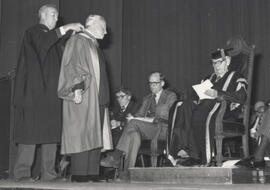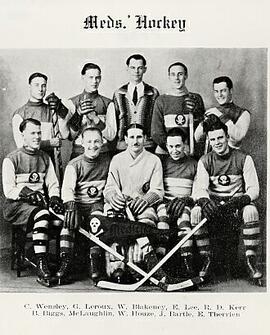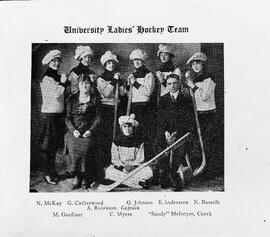Honourary Degrees - Presentation - Colonel Robert L. Houston
- A-6545
- Item
- May 1979
Emmett M. Hall, University Chancellor, is making presentation of an honourary Doctor of Laws degree to Colonel Robert L. Houston at Convocation at Centennial Auditorium. Iain MacLean, University Secretary, prepares to hood recipient.
Bio/Historical Note: Col. Robert Laird (Bob) Houston was born in Melville, Saskatchewan in 1911. He grew up in Arnprior, Ontario and then attended Clarkson University in Potsdam, New York on a hockey scholarship from which he graduated in 1934 with a degree in Electrical Engineering. In 1935 he was commissioned into the Canadian Army. He served in various capacities in the Army until retiring as a Colonel in 1963, including fighting in World War II as a Commanding Officer of the Fourth Canadian Armoured Divisional Signals and being awarded the French Croix de Guerre, instructing at the Canadian Army Staff College in Kingston, Ontario and the NATO Defence Staff College in Paris, France and serving on different international committees. In 1963 Col. Houston founded the Canada Japan Trade Council and led the Council until his retirement. In 1987 he was awarded the Order of the Sacred Treasure, Star from His Majesty, The Emperor of Japan for his efforts through the years to promote friendly relations and economic ties between Canada and Japan. Col. Houston initiated the Western Transportation Advisory Council and he is a past chairman of the Canadian National Committee of United World Colleges (which ultimately led to the establishment of the Lester B. Pearson College of the Pacific), past president of Clarkson University Alumni Board of Governors, past President of the NATO Defence College Association of Canada, past Chairman of the National Committee for the Diefenbaker Canada Centre and a past Director of the Royal Canadian Geographic Society and the Big Rideau Lake Association. Col. Houston died in Ottawa in 2002 at age 90.




